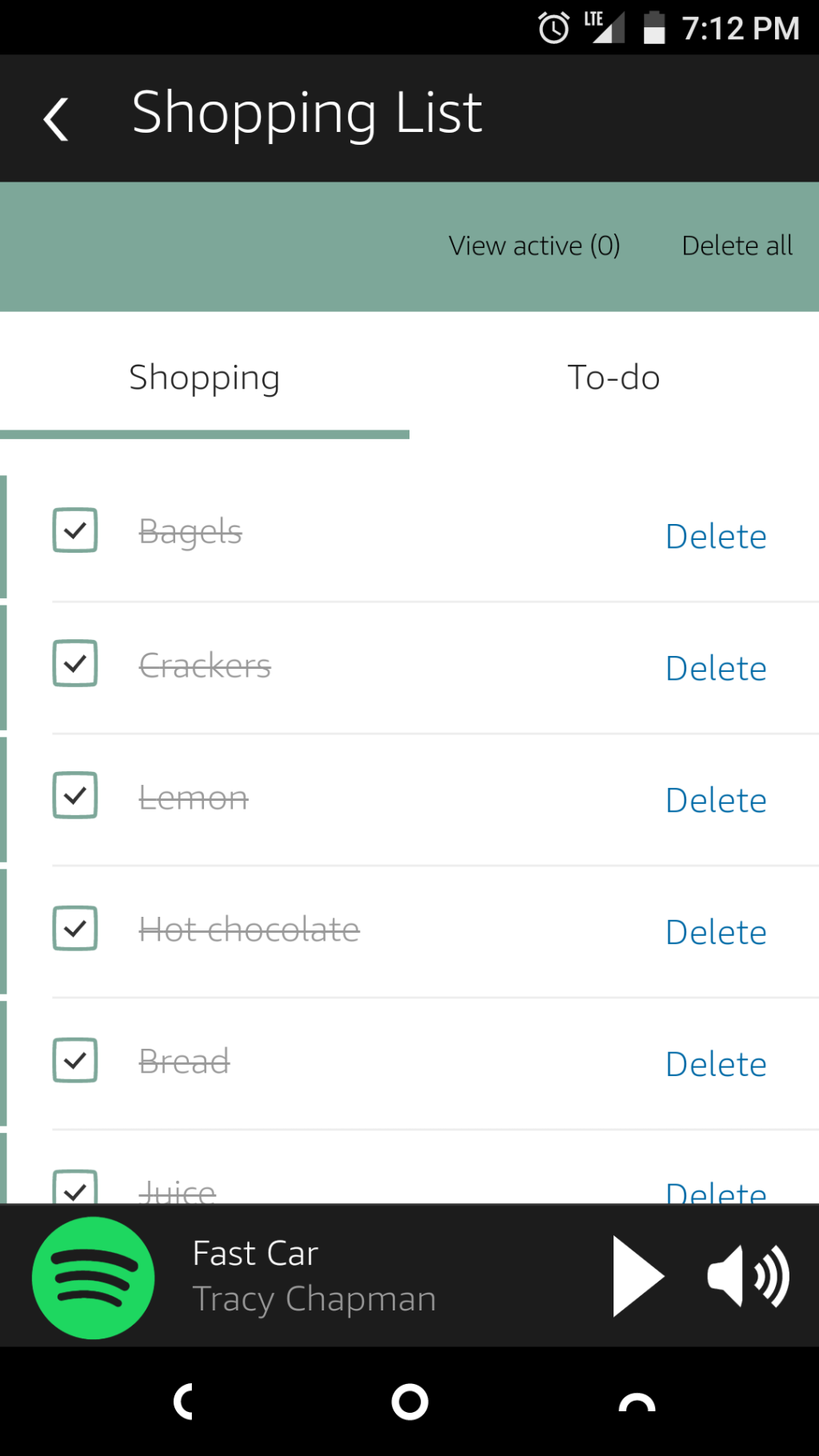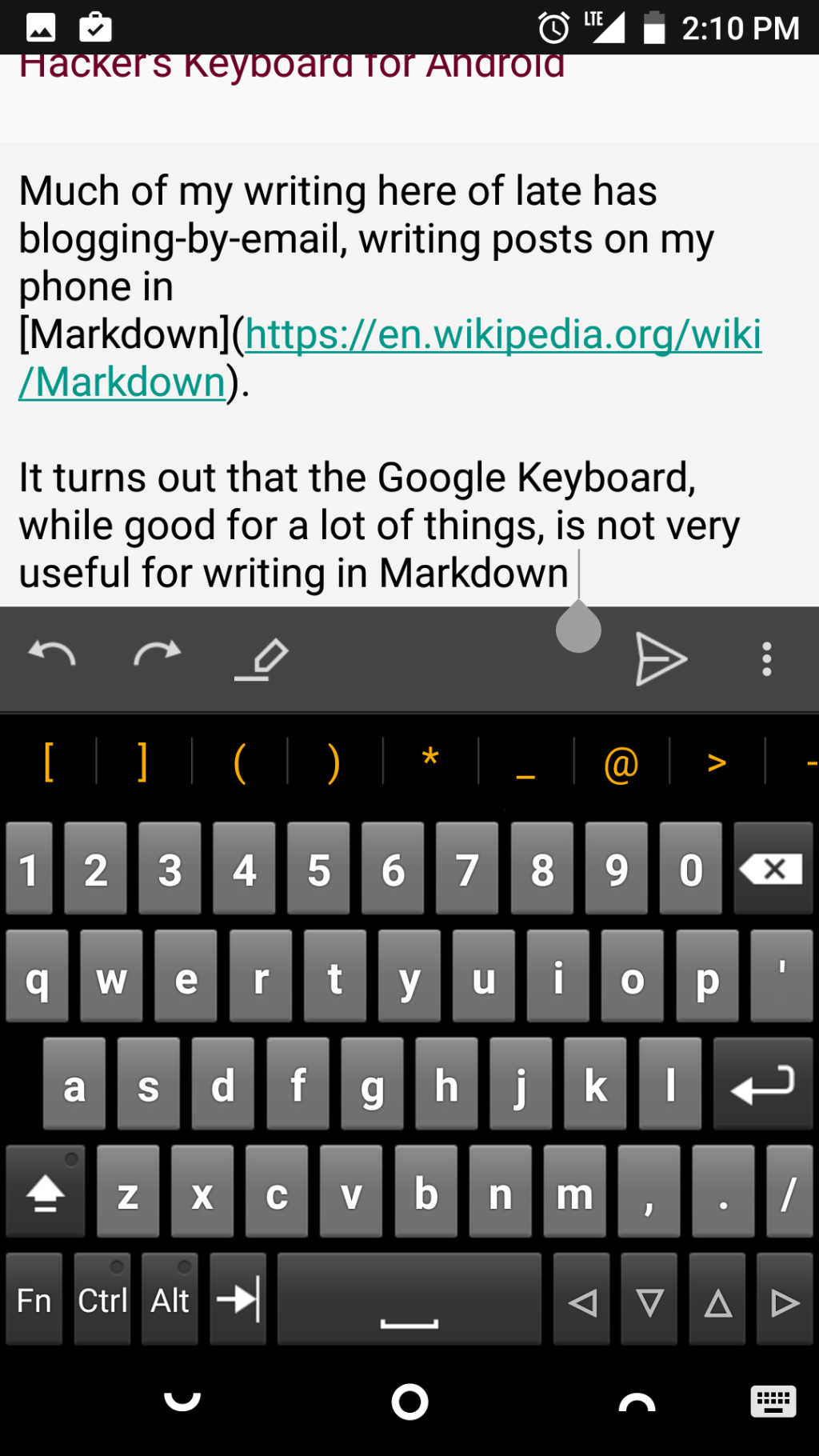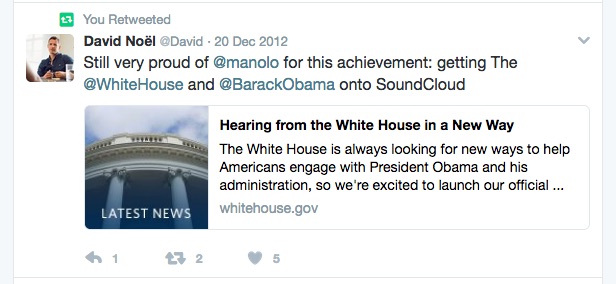The shopping list feature may be what endears our family to the Amazon Echo most of all. That, and “Alexa, turn on the living room light.” Oh, and “Alexa, tell Spotify to play Talking Heads.”

One of the more interesting side-effects of the election of President Donald Trump is that Oliver has become a devotee of Robert Reich and his Inequality Media project.
Update: The head of our Vermont operation forwarded a link to the Indivisible Guide, which comes from a similar mindset. Oliver listened to the the beginning of the audio version of the guide over breakfast this morning, and this precipitated a conversation, en route to school, about the differences between federal governance in the U.S. and Canada.
Much of my writing here of late has been blogging-by-email, writing posts on my phone in Markdown.
It turns out that the Google Keyboard, while good for a lot of things, is not very useful for writing in Markdown, mostly because inserting links required the [, ], ( and ) characters, and there’s a lot of shifting required to type these.
So I’m experimenting with the open source Hacker’s Keyboard, which lets me stick these characters, along with some other characters useful for Markdown, in a 6th row of the keyboard.
It’s taking some getting used to, this new layout. And I do miss the ability to type-by-swiping dearly, so this might not stick. But I wrote this with the new keyboard and at least the Markdown bits were easier.

Jennifer Herrema, interviewed in The Creative Independent, on her retirement plan:
But it’s not like I have a family to take care of. I own my house, I bought it. I was broke after purchasing it but I don’t have a mortgage, I don’t have car payments, so whatever. Fuck retirement, I don’t care. I always knew that that’s the way it’s going to be. I’m just gonna keep making my shit and whatever happens will happen. Hopefully it will be cool.
Minus the no-family part, that’s about as close a description of my retirement plan as I’ve come across. I also hope it will be cool.
The FAQ for Saturday’s PEI Writers’ Guild Erotic Writing Workshop is almost enough to make me sign up.
Q: Aren’t you worried about attracting, you know, weirdos?
A: Well, Writers Guild members tend to be a well-behaved bunch, so no, not really. But if anyone is disruptive, a 500-pound cow will fall on their head, they will be asked to leave, and UPEI campus security will see them out. Plus we’ll take away their chocolate.
I said almost. As someone who blushes beet red at merest mention of the possibility of canoodling, I’m fairly confident that I don’t have the fortitude.
Oliver was getting ready for bed tonight.
“I watched this episode of Black Mirror today that you wouldn’t be able to watch,” I said. “It was very scary, with horror and a scary mansion, and spiders and fighting.”
“I already saw that episode,” Oliver replied.
Discussion ensued: Oliver’s always expressed a strong aversion to anything of this ilk.
“Was watching that episode sort of like how you ate all the kimchi at Seoul Food the other day, even though it was very spicy?”, I asked him.
“Yes!”, he replied enthusiastically. “It’s quality content, that’s scary. Kimchi is quality food, that’s very spicy.”
We looked up the Common Sense Media guide to Black Mirror and we agreed with its advice: good for older teens, too much for kids. Your kid may vary.
Oliver and I were sitting in the car in the high school parking lot yesterday, waiting for his EA to arrive.
I noticed that there were still insect wipes stored in the dash, leftover from summer.
“We won’t be needing those on a day like today,” I said. “Any mosquito that’s outside today would have to be a pretty special mosquito.”
“An extremophile,” replied Oliver, as though it was the most natural thing in the world to say.
Extremophile was the Merriam-Webster Word of the Day on Monday; that’s a website that’s on the school agenda for Oliver every morning. Obviously it’s of some utility.
Since I imploded my Twitter last month, a few strange things have happened.
First, I haven’t missed it.
This was really surprising, because while I was in the thick of Twitter it seemed tantamount to oxygen or coffee and the thought of doing without it seemed as odd as giving up either of those. But now, cold turkey as I am, I don’t miss it. At all.
Actually, that’s not completely true: in the same way that cutting back on sugar caused me to not miss sugar, but more to lament the absence of the ability of it to give me a kick, I also miss the role of Twitter in my life more for the vacuum it created.
I’m not jonesing for a Snickers bar, but I miss the role that Snickers bars once played in my life. Like an old friend who moved to Australia.
Second, it seems that I broke Twitter.
Here’s what my Twitter profile page header looks like:

Twitter seems to think that I have 1,149 “likes”, even though I deleted all of them. Indeed, if I navigate to my likes page, Twitter tells me “You haven’t liked any Tweets yet.”

Similarly, Twitter things that I’ve tweeted 30 times. When, in fact, I left a single tweet in place when I purged my archive: the first one, tweeted December 12, 2006.
On my timeline, in addition to that tweet, are an additional 6 retweets that, for some reason unknown, I cannot “un-retweet,” despite trying in myriad ways. The only thing these retweets have in common is that they’re old, and the original tweets were from simply-named longtime Twitter users (@David and @Alby). Like this one:

Perhaps these retweets were done in some earlier-era no-long-supported-and-cannot-be-undone manner. I seem to be stuck with them.
Perhaps Twitter received too much of a shock to the system by my wholesale withdrawal, and some regular re-indexing process will correct the above.
Fortunately, I don’t have to care about this because I’ll be using all the free time I have now while I’m not Tweeting to learn Mandarin or take afternoon naps.
I have been a fan of Stephen Fearing for almost 30 years, ever since Beguiling Eyes, from his 1988 album Out to Sea, soothed my tortured soul on many lonely nights in the late 1980s.
His new album, Every Soul’s a Sailor is the rightful heir to that first album, especially the title track, which is lovely.
Of the album, and that song, Fearing writes:
Musically, I have traveled consistently between the two poles of “solo” and “ensemble”. With this album I wanted to see if I could bring those two worlds together in the studio and then out on the road, touring with a trio. I deliberately set out to write the songs with an ensemble in mind and from the very start I tried to imagine how the tunes would sound played live by a trio. Most of this material was written or finished during a week-long trip into the mountains, where I holed up at a friend’s cabin in Wells BC. with a woodstove and a fine collection of eclectic roots music to listen to when I ran out of steam. I brought my Telecaster and my trusty Manzer acoustic, a small amplifier and a goodly supply of pencils and paper. Certainly the title song could not have been written anywhere else.
On the ensemble end of that spectrum are the equally lovely tracks Gone But Not Forgotten and Red Lights in the Rain, both of which feature harmony by the transcendent Rose Cousins.
I last saw Fearing play live, in Sackville, three years ago; it was a great night, a port in a storm of personal chaos that came just at the right time. If you have a chance to hear him tour this album, I recommend it.

 I am
I am